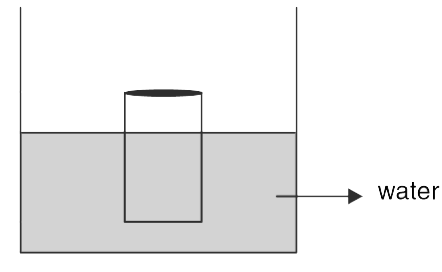A block of wood is floating on water at 0∘C with a certain volume 'V' above the water level. The temperature of water is slowly raised to 20∘C . How does the volume 'V' change with the rise in temperature ?Solution in Tamil
remains unchanged
decrease continuously
decrease till 4∘C and then increase
increase till 4∘C and then decrease
The correct Answer is:D
increase till 4∘C and then decrease
Topper's Solved these Questions
- SOLVED PAPER 17 (UNSOLVED)BOOK - FULL MARKSCHAPTER - SOLVED PAPER 17 (UNSOLVED)EXERCISE - Part -II
9 Videos
- SOLVED PAPER 17 (UNSOLVED)BOOK - FULL MARKSCHAPTER - SOLVED PAPER 17 (UNSOLVED)EXERCISE - Part -III
8 Videos
- SOLVED PAPER 12 (UNSOLVED)BOOK - FULL MARKSCHAPTER - SOLVED PAPER 12 (UNSOLVED)EXERCISE - Part - IV
10 Videos
- WAVES BOOK - FULL MARKSCHAPTER - WAVES EXERCISE - Additional Questions Solved (Numerical Problems )
10 Videos
Similar Questions
What are the limitations of dimensional analysis?
View SolutionHow can the systematic errors be minimised?
View SolutionWhat is significant figures?
View SolutionThe fundamental frequency of a closed organ pipe is equal to the first overtone of an open organ pipe. If the length of the open pipe is 60 cm, What is the length of the closed pipe?
View SolutionA block of wood is floating in water at 0^@ C . The temperature of water is slowly raised from 0^@ C to 10^@ C . How will the precentage of volume of block above water level change with rise in temperature?
View SolutionA block of wood is floating on water at 0^(@)C with a certain volume V above water level. The temperature of water is slowly raised to 20^(@)C . How does the volume V change with the rise of temperature ?
View SolutionA cyclindrical ice block is floating in water 10% of its total volume is outside water. Kerosene oil (relative density=0.8) is poured slowly on top of water in the container. Assume that the oil does not mix with water. Height of the ice cylinder is H.

(a) As kerosene is poured, how does the volume of ice block above the water level change?
(b) What is the thickness of kerosene layer above the water when 20% of the volume of the ice block is above the water surface?
(c) Find the ratio of voume of ice block is kerosene to its volume in water after the kerosene layer rises above the top surface of ice and the block gets completely submerged. Neglect any melting of ice.
View SolutionA block of wood is floating on water at 0∘C with volume V0 above water. When the temperature of water increases from 0 to 10∘C, the change in the volume of the block That is above water is best described schematically by the graph
View SolutionA block of wood is floating on water at 0∘C with a certain volume V outside the water-level. The temperature of water is slowly raised from 0∘C to 20∘C . How will the volume V change with rise in temperature ?
View SolutionA wooden block is floating on water at 0∘C keeping a portion V of its volume outside water. If the temperature of the water is increased from 0∘C to 20∘C, then what change of V will be observed?
View SolutionA wooden block floats in water keeping a volume V of it above the surface, at 0∘C. If the temperature of water is slowly raised from 0∘C to 20∘C, what will be the change in the value of V ?
View SolutionA wooden block is floating on water at 1^@C with volume v above the water level. If the temperature of water starts increasing slowly, how will the volume of block above the water level is affected?
View SolutionA block of wood is floating on water at 0∘C with a certain volume 'V' above the water level. The temperature of water is slowly raised to 20∘C . How does the volume 'V' change with the rise in temperature ?
View SolutionA block of wood is floating on water at 0∘C, with a certain volume V above water level. The temperature of water is slowly raised from 0∘C. How will the volume V change with the rise of temperature?
View SolutionA block of wood is floating on water at 0^@C with a certain volume V above the level of water. The temperature of water is gradually increased from 0^@C to 8^@C . How does the volume V change with the change of temperature ?
View Solution
